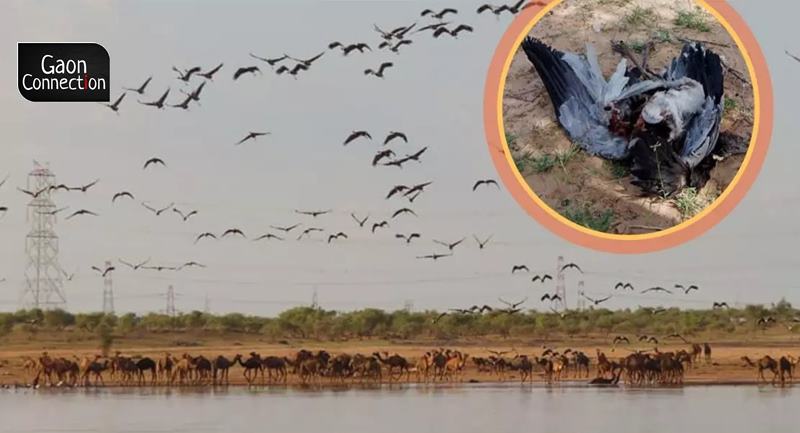Migratory birds take the early flight into Rajasthan; but many of them crash into overhead power lines
There is rejoicing amongst wildlife enthusiasts in Western Rajasthan as many rare and endangered species of birds have been spotted flying in earlier than usual. However, there is great distress too, as in the space of just 20 days last month, 18 migratory birds were killed when they came into contact with overhead power cables of renewable energy projects in the state


High tension wires in the flight path of the migratory birds have become a cause of concern for environmentalists.
Jaisalmer, Rajasthan
Jaisalmer in western Rajasthan, is where thousands of migratory birds flock in the winter months. Nearly 150 different kinds of birds arrive at the Thar desert in the state, and this year, the birds are a little ahead of schedule. According to keen bird watchers, a few new species have also been spotted this time.
However, amidst all the rejoicing has been some bad news. This year, in Jaisalmer alone, between October 4 and October 26, as many as 18 migratory birds were killed when they flew into high tension wires in the state. These included 14 Demoiselle cranes, 3 endangered species of hawks and a duck.
The overhead power lines of the wind and solar plants across Jaisalmer are proving to be a hazard to the birds. A number of power generating companies are coming up in the wide open spaces of the state. The electricity they generate is lighting up many homes in Rajasthan. However, they are spelling doom to the migratory birds.
Also Read: ‘Green’ energy projects threaten to wipe off ancient ‘orans’ in Jaisalmer, Rajasthan
“These birds that fly all the way from Mongolia and other parts of Central Asia, into Rajasthan are an integral part of local traditions and lore,” Bhopal Singh Jhaloda, a Jaisalmer-based environmentalist, told Gaon Connection. However he expressed distress at the number of deaths of the birds.

“We do not really know the exact number of birds that have died. Usually, these birds are visible in huge swarms, but this time they have been arriving in smaller flocks too,” the environmentalist added.
High tension wires in the flight path of the migratory birds have become a cause of concern for environmentalists. Taking cognisance of this the Supreme Court, in March, 2021, had directed the power companies in Degrai Oran in Jaisalmer, to lay underground cables.
Also Read: Rajasthan: Camels and sheep to face a fodder crisis as about 600-year-old Oran is being uprooted
Early visitors
“The houbara bustard belonging to the Great Indian Bustard family, is a vulnerable species. Found in Central Asia, the bustard travels across Afghanistan and Pakistan and arrives in great numbers into western Rajasthan and Gujarat, usually in November,” Nand Kishore, a Jaisalmer-based wildlife enthusiast, told Gaon Connection.
“However, this year the bustard has been spotted right from the end of August. Ornithologists consider this as a sign of improving the environment in these areas,” he added.
Every year, in September, Jodhpur district sees an influx of the Demoiselle crane, especially in Khichan village in the Phalodi area of the district. This year the guests arrived on August 26. Experts said that the abundance of water in the canals in the Thar area could be another reason for their flocking in such great numbers.

Also Read: Kachchh villagers on vigil to save Sangnara forest from a windmill project
“A significant climate change may be one of the reasons the birds have come early to Rajasthan,” Sanjeev Kumar, former joint director, Zoological Survey of India, told Gaon Connection. The increase in rainfall in the past month in the desert state has also made it attractive for the birds to come in early, environmentalists say.
High tension power lines, a death trap
However, generating clean energy is coming in the way of the migratory birds. The Wildlife Institute of India, had prepared a report in 2020 where it referred to the great danger high tension power lines posed to the birds, especially the Great Indian Bustard.
In Jaisalmer alone, annually, nearly 83,000 birds of various species die after they come into contact with the wires.
“The state government has turned a blind eye to the problem. Solar power companies in Bhimsar, Bhopa, Sawata, and Rasala villages have laid out a net of overhead power lines. Even the forest department is doing nothing to prevent the bird deaths,” Sumer Singh, environmental activist in Jaisalmer, told Gaon Connection.
“We have represented the matter to the district collector and, under the Wild Life (Protection) Act of 1972, asked to put a stop to the work being done by the power plants,” Sumer Singh added.
The local inhabitants who enjoy the yearly arrival of the birds are disturbed by the reports of the death of the birds.

“The arrival of migratory birds is a matter of rejoicing for us. It means the birds find a sanctuary in our land. It is therefore the duty of each one of us as well as the administration to enable the safety and conservation of these birds,” Chaitanya Raj Singh, a wildlife enthusiast and a member of the former royal family of Jaisalmer, told Gaon Connection. “It is carelessness and neglect on our part and I appeal to the administration to look into the matter,” he added.
Meanwhile, in Jaisalmer, songs are being sung and stories told about the migratory birds. And, the deserts of Thar are coming alive with the flutter of wings as bustards, yellow-eyed pigeons, pelicans, social lapwings, etc, fly in to enjoy a winter stay. The water bodies are filled with bird song morning and night. “It is obvious the birds love Jaisalmer,” observed a bird lover from a nearby village.
Read the story in Hindi

